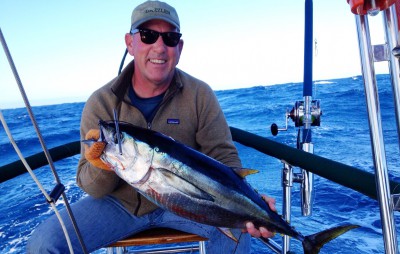Fourteen years of living aboard and actively cruising since 2009, I have developed an essential must have list of items aboard a cruising sailboat. There are many different categories to focus on such as galley items, engine spare parts, tools, personal items, safety items and recreational items. I could make lists all day long of what I have deemed to be necessary in any one of these categories. So, I will provide a general overall list of things that I have found to be invaluable. The list is in no particular order of preference.
1) Nebo multi tool. 
2). Spare head parts or a rebuild kit and spare head hose.
3). Spare fresh water supply pump.
4). Spare halyard.
5). Self-steering system.
6). Fishing equipment.
7). Proven quality ground tackle and chain rhode.
8). Chafe protection equipment.
9). Tested and working personal safety equipment.
10). Spare engine seals and repair parts.
11). Watermaker.
12). Spare fans.
Discussion:
- Of all the tools I have onboard the Nebo is my first goto tool for the majority of repairs onboard. I will sometimes add a ¼” drive extension and ¼” ratchet to my go fix bag. The Nebo has become such a favorite tool that I have a second one onboard in case I lose my working model. From experience, once the Nebo falters from your hands bounces across the deck of your boat and into the hands of Davey Jones, a sinking feeling of great loss will come over you. It’s that useful. A quick search on the internet will reveal where you can get yours.
- If you have been cruising for years or are a weekend boater you will know of the double- edged sword that a head provides you and your crew. On one hand it is necessary for doing your business. It is also one of the most talked about issues on a boat amongst cruisers. Having a rebuild kit in foreign places is critical to continued enjoyment. If the head isn’t working, nobody is happy. Store enough spare head hose to replace your head hose. Sanitation hose is hard to find and when you do find good quality hose, you usually have to pay dearly for it.
- Perhaps you like to take chances, but if you want to drink fresh water or shower or do laundry, I suggest you have multiple sources of fresh water delivery systems onboard. Many boats come with manual backup pumps activated by hand or foot. This is an excellent backup. But, many of us have become accustom to turning a knob and watching fresh water pour into our pans, glasses or ice trays. Be prepared!
- There are so many types of lines being used for halyards. Whatever line you chose to use, have a backup halyard. I had a double braid halyard with a spectra core. My line clutch over the period of about two weeks chafed through the jacket and it was next to impossible to make fast the damaged line. At the very least save your old halyard as a backup in the event you have a halyard mishap.
- Okay, I know there are some hard core sailors out there and some that want to utilize the most recent technology. Whatever your self-steering system is, have spare parts. Whether it’s a spare autopilot computer or wind driven steering systems. Parts wear out, go bad, stop working properly and cause a major inconvenience in far away places. The land of plenty is usually too far away to help. FRED (Freakin’ Remarkable Electronic Device) is my best crewmate. It can steer far better than I and as a single handed sailor it provides me with continuing forward toward the next anchorage while being able to relax with confidence.
- Contrary to popular belief there are not an abundance of grocery stores at every anchorage waiting for you to swipe your debit card. So, fishing becomes a source of healthy protein to supplement your diet. If you don’t know how to clean fish or deal with a fish check out my upcoming article on fishing. Once you find a certain lure or lures that are successful for catching fish, get extras. A hand line, rod and reel, fish stringer, de-hooking tool, gaff and your favorite recipe are some equipment to start with. Have extra hooks and terminal tackle to replace those items that wear out. I will be posting a comprehensive post in the future from a fishing seminar I teach in La Cruz, Mexico near Puerto Vallarta, on utilizing a hand line from your cruising sailboat.
- This controversial issue can be discussed in volumes of internet pages. Practice using your ground tackle no matter what you decide to use. This will result in building your confidence factor. Many boats have found their way onto distant shores because the ground tackle failed. The failure could include but is not limited to inadequate anchor for the sea floor, undersized anchor, improper setting techniques, old chain that should find its way out of service and rhode that is insufficient or undersized for the weight of your vessel. I have witnessed the results of many vessels that have made their way to the beaching and not in a good way. Many of these boats were unoccupied at the time. It is very easy to get lulled into a false sense of security in what appears to be safe anchorages where many boaters will leave their vessels unattended while heading to shore for some time off the boat. Your vessel is your home, friend and family. Provide the best ground tackle you can. Research the breaking strengths of chain and rhode before you put down your $$.
- Chafe protection is used in a broad spectrum of areas on your boat. From placing chafe protection on contact points of working sheets, anchor snubber lines, reefing lines, equipment below deck, etc… Chafe protection can be strakes, used fire hose jackets, reinforced hose or just about anything. Lines can chafe as well as wooden combings and han rails and fiberglass surfaces. Anyplace there are working and non working parts touching or rubbing you have the potential for chafe and could add some form of protection against chafe.
- Many boaters have personal safety equipment. Personal floatation devices (PFD), safety strobes, jack lines and tethers. Ask yourself when was the last time you checked to see if your self inflating vest worked as designed. I know there is cost involved in setting off your PFD’s but every two years I dip mine into the water to make sure they will function. Then I rearm and repack them. This will also build your confidence in knowing how they will actually work. If you have an automaticly activated strobe attached to your PFD make sure it fires off and rearm it as well. Sorry folks, personal safety is a no nonsense issue for me. If you rely on it, maintain it and know that it works. Nothing is free in Water World!
- If you have ever left your boat and gone on a parts safari in foreign lands you will know that diesel parts don’t grow on trees. Sometimes I have spent two days looking for a Tienda that specializes in bearings and has or can get the correct bearing for your repairs. Honestly, going on parts safari is a great way to find out what is actually available in the area as well. There are however, proprietary parts that are only sold or available from the specific engine manufacturer. Like ceramic mechanical seals for raw water pumps. These types of things should be carried as spares. I know, I know, which spares do we store in our cruising sailboat. I like to think of it as the Costco® principle. If you think you need it, get it. Because when you truly need it in a foreign land you will be glad you have it. My experience is that many parts are available in different areas around the world, but many specialized or proprietary parts are only available through a manufacturer or their representative.
- I know many cruisers that wrestle with the decision of equipping their vessel with a water maker or not. Then they struggle with the cost verses size. Having the ability to make your own potable water from seawater frees you from the hose tether and perhaps then only non potable water. Too many friends have opted for a water maker that is rated at two or four gallons per hour. Perhaps it’s a price point or space consideration that is a consideration as well. Their output is usually less than claimed. I have personally shared my fresh water with other cruisers in remote locations when the local water source dried up or was no longer available. I chose to be more self-reliant and made the room and bit the bullet on the price to have adequate water supply. I haven’t even mentioned the potential for injury while carrying heavy water jugs over slippery rocks or creaky docks. Water! We cannot survive without it!
- Tropical and arid regions around the world increase heat exposure to our vessel’s interiors. The interiors get warm and without air breezing through our boat it becomes stale and uncomfortable to sleep or occupy below deck. Install plenty of fans and bring a few spares. Finding 12 volt fans is difficult at times. When you do find them, you recall how much you paid for them in your home country and you realize that you didn’t have room onboard for your leprechaun, pot of gold or money tree. A DC fan is still a DC fan and it can make the difference between a good nights sleep and …. Well you know.
I hope that this has helped someone out there. I will be the first to say that experience is only good if it’s shared and someone benefits.
Fair Winds!
Captain Dan
SV Dazzler











I would feel very safe sailing with Dan!!!